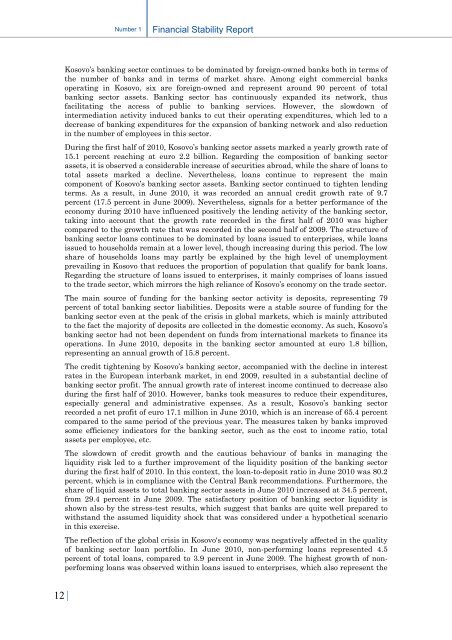Financial Stability Report No1 20 December 2010 - Banka Qendrore ...
Financial Stability Report No1 20 December 2010 - Banka Qendrore ...
Financial Stability Report No1 20 December 2010 - Banka Qendrore ...
Create successful ePaper yourself
Turn your PDF publications into a flip-book with our unique Google optimized e-Paper software.
Number 1<strong>Financial</strong> <strong>Stability</strong> <strong>Report</strong>Kosovo’s banking sector continues to be dominated by foreign-owned banks both in terms ofthe number of banks and in terms of market share. Among eight commercial banksoperating in Kosovo, six are foreign-owned and represent around 90 percent of totalbanking sector assets. Banking sector has continuously expanded its network, thusfacilitating the access of public to banking services. However, the slowdown ofintermediation activity induced banks to cut their operating expenditures, which led to adecrease of banking expenditures for the expansion of banking network and also reductionin the number of employees in this sector.During the first half of <strong>20</strong>10, Kosovo’s banking sector assets marked a yearly growth rate of15.1 percent reaching at euro 2.2 billion. Regarding the composition of banking sectorassets, it is observed a considerable increase of securities abroad, while the share of loans tototal assets marked a decline. Nevertheless, loans continue to represent the maincomponent of Kosovo’s banking sector assets. Banking sector continued to tighten lendingterms. As a result, in June <strong>20</strong>10, it was recorded an annual credit growth rate of 9.7percent (17.5 percent in June <strong>20</strong>09). Nevertheless, signals for a better performance of theeconomy during <strong>20</strong>10 have influenced positively the lending activity of the banking sector,taking into account that the growth rate recorded in the first half of <strong>20</strong>10 was highercompared to the growth rate that was recorded in the second half of <strong>20</strong>09. The structure ofbanking sector loans continues to be dominated by loans issued to enterprises, while loansissued to households remain at a lower level, though increasing during this period. The lowshare of households loans may partly be explained by the high level of unemploymentprevailing in Kosovo that reduces the proportion of population that qualify for bank loans.Regarding the structure of loans issued to enterprises, it mainly comprises of loans issuedto the trade sector, which mirrors the high reliance of Kosovo’s economy on the trade sector.The main source of funding for the banking sector activity is deposits, representing 79percent of total banking sector liabilities. Deposits were a stable source of funding for thebanking sector even at the peak of the crisis in global markets, which is mainly attributedto the fact the majority of deposits are collected in the domestic economy. As such, Kosovo’sbanking sector had not been dependent on funds from international markets to finance itsoperations. In June <strong>20</strong>10, deposits in the banking sector amounted at euro 1.8 billion,representing an annual growth of 15.8 percent.The credit tightening by Kosovo’s banking sector, accompanied with the decline in interestrates in the European interbank market, in end <strong>20</strong>09, resulted in a substantial decline ofbanking sector profit. The annual growth rate of interest income continued to decrease alsoduring the first half of <strong>20</strong>10. However, banks took measures to reduce their expenditures,especially general and administrative expenses. As a result, Kosovo’s banking sectorrecorded a net profit of euro 17.1 million in June <strong>20</strong>10, which is an increase of 65.4 percentcompared to the same period of the previous year. The measures taken by banks improvedsome efficiency indicators for the banking sector, such as the cost to income ratio, totalassets per employee, etc.The slowdown of credit growth and the cautious behaviour of banks in managing theliquidity risk led to a further improvement of the liquidity position of the banking sectorduring the first half of <strong>20</strong>10. In this context, the loan-to-deposit ratio in June <strong>20</strong>10 was 80.2percent, which is in compliance with the Central Bank recommendations. Furthermore, theshare of liquid assets to total banking sector assets in June <strong>20</strong>10 increased at 34.5 percent,from 29.4 percent in June <strong>20</strong>09. The satisfactory position of banking sector liquidity isshown also by the stress-test results, which suggest that banks are quite well prepared towithstand the assumed liquidity shock that was considered under a hypothetical scenarioin this exercise.The reflection of the global crisis in Kosovo's economy was negatively affected in the qualityof banking sector loan portfolio. In June <strong>20</strong>10, non-performing loans represented 4.5percent of total loans, compared to 3.9 percent in June <strong>20</strong>09. The highest growth of nonperformingloans was observed within loans issued to enterprises, which also represent the12 |
















